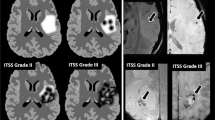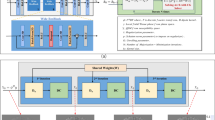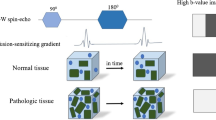Abstract
Background and purpose
Brain tumors may dislocate, infiltrate, or disrupt the adjacent fiber tracts. We examined (1) microstructural changes of white matter (WM) adjacent to supratentorial low grade tumors in children and (2) WM tracts of the affected hemisphere using diffusion tensor imaging (DTI). We hypothesized that the structural integrity of the adjacent WM tracts would be preserved in these slow-growing tumors.
Materials and methods
DTI was performed in 11 children with low grade tumors diagnosed by magnetic resonance imaging (MRI). Regions of interest were placed in the tumor, in WM adjacent to tumor, and on the normal contralateral side. Fractional anisotropy (FA), trace, and eigenvalues were measured. Color-coded maps and tractography were used to grade the WM tracts: Grade one was normal tract size and color hue; grade two was reduced tract size but preserved color hue; and grade three was loss of color hue or failure to track on tractography. Grades one and two were subcategorized as “a” or “b,” depending on the absence or presence of tract displacement.
Results
There were no significant differences in FA, trace, and eigenvalues between WM adjacent to tumor and the contralateral side. One patient had grade 1a changes, six grade 1b, and four grade 2b.
Conclusion
We found preserved microstructural integrity of WM adjacent to low grade tumors in children. Color vector maps and tractography demonstrated displacement of the WM tracts in all but one patient. Our findings could be useful for neurosurgical planning to minimize injury to the WM tracts and improve preoperative risk analysis.




Similar content being viewed by others
References
Bammer R, Acar B, Moseley ME (2003) In vivo MR tractography using diffusion imaging. Eur J Radiol 45:223–234
Basser PJ (1995) Inferring microstructural features and the physiological state of tissues from diffusion-weighted images. NMR Biomed 8:333–344
Ciccarelli O, Toosy AT, Parker GJ, Wheeler-Kingshott CA, Barker GJ, Miller DH, Thompson AJ (2003) Diffusion tractography based group mapping of major white-matter pathways in the human brain. Neuroimage 19:1545–1555
Field AS, Alexander AL (2004) Diffusion tensor imaging in cerebral tumor diagnosis and therapy. Top Magn Reson Imaging 15:315–324
Field AS, Alexander AL, Wu YC, Hasan KM, Witwer B, Badie B (2004) Diffusion tensor eigenvector directional color imaging patterns in the evaluation of cerebral white matter tracts altered by tumor. J Magn Reson Imaging 20:555–562
Field AS (2005) Diffusion tensor imaging at the crossroads: fiber tracking meets tissue characterization in brain tumors. AJNR Am J Neuroradiol 26:2168–2169
Field AS, Wu YC, Alexander AL (2005) Principal diffusion direction in peritumoral fiber tracts: Color map patterns and directional statistics. Ann N Y Acad Sci 1064:193–201
Gauvain KM, McKinstry RC, Mukherjee P, Perry A, Neil JJ, Kaufman BA, Hayashi RJ (2001) Evaluating pediatric brain tumor cellularity with diffusion-tensor imaging. AJR Am J Roentgenol 177:449–454
Goebell E, Paustenbach S, Vaeterlein O, Ding XQ, Heese O, Fiehler J, Kucinski T, Hagel C, Westphal M, Zeumer H (2006) Low-grade and anaplastic gliomas: differences in architecture evaluated with diffusion-tensor MR imaging. Radiology 239:217–222
Guo AC, Cummings TJ, Dash RC, Provenzale JM (2002) Lymphomas and high-grade astrocytomas: comparison of water diffusibility and histologic characteristics. Radiology 224:177–183
Helton KJ, Phillips NS, Khan RB, Boop FA, Sanford RA, Zou P, Li CS, Langston JW, Ogg RJ (2006) Diffusion tensor imaging of tract involvement in children with pontine tumors. AJNR Am J Neuroradiol 27:786–793
Inoue T, Ogasawara K, Beppu T, Ogawa A, Kabasawa H (2005) Diffusion tensor imaging for preoperative evaluation of tumor grade in gliomas. Clin Neurol Neurosurg 107:174–180
Jiang H, van Zijl PC, Kim J, Pearlson GD, Mori S (2006) DtiStudio: resource program for diffusion tensor computation and fiber bundle tracking. Comput Methods Programs Biomed 81:106–116
Kamada K, Todo T, Morita A, Masutani Y, Aoki S, Ino K, Kawai K, Kirino T (2005) Functional monitoring for visual pathway using real-time visual evoked potentials and optic-radiation tractography. Neurosurgery 57:121–127 (discussion 121–127)
Kim CH, Chung CK, Kim JS, Jahng TA, Lee JH, Song IC (2007) Use of diffusion tensor imaging to evaluate weakness. J Neurosurg 106:111–118
Kinoshita M, Yamada K, Hashimoto N, Kato A, Izumoto S, Baba T, Maruno M, Nishimura T, Yoshimine T (2005) Fiber-tracking does not accurately estimate size of fiber bundle in pathological condition: initial neurosurgical experience using neuronavigation and subcortical white matter stimulation. Neuroimage 25:424–429
Kono K, Inoue Y, Nakayama K, Shakudo M, Morino M, Ohata K, Wakasa K, Yamada R (2001) The role of diffusion-weighted imaging in patients with brain tumors. AJNR Am J Neuroradiol 22:1081–1088
Laundre BJ, Jellison BJ, Badie B, Alexander AL, Field AS (2005) Diffusion tensor imaging of the corticospinal tract before and after mass resection as correlated with clinical motor findings: preliminary data. AJNR Am J Neuroradiol 26:791–796
Mikuni N, Okada T, Enatsu R, Miki Y, Hanakawa T, Urayama S, Kikuta K, Takahashi JA, Nozaki K, Fukuyama H, Hashimoto N (2007) Clinical impact of integrated functional neuronavigation and subcortical electrical stimulation to preserve motor function during resection of brain tumors. J Neurosurg 106:593–598
Mori S, van Zijl PC (2002) Fiber tracking: principles and strategies - a technical review. NMR Biomed 15:468–480
Nimsky C, Ganslandt O, Hastreiter P, Wang R, Benner T, Sorensen AG, Fahlbusch R (2005) Intraoperative diffusion-tensor MR imaging: shifting of white matter tracts during neurosurgical procedures—initial experience. Radiology 234:218–225
Nimsky C, Ganslandt O, Fahlbusch R (2006) Implementation of fiber tract navigation. Neurosurgery 58:ONS–292–303 (discussion ONS-303–304)
Stadlbauer A, Nimsky C, Gruber S, Moser E, Hammen T, Engelhorn T, Buchfelder M, Ganslandt O (2007) Changes in fiber integrity, diffusivity, and metabolism of the pyramidal tract adjacent to gliomas: a quantitative diffusion tensor fiber tracking and MR spectroscopic imaging study. AJNR Am J Neuroradiol 28:462–469
Stieltjes B, Schluter M, Didinger B, Weber MA, Hahn HK, Parzer P, Rexilius J, Konrad-Verse O, Peitgen HO, Essig M (2006) Diffusion tensor imaging in primary brain tumors: reproducible quantitative analysis of corpus callosum infiltration and contralateral involvement using a probabilistic mixture model. Neuroimage 31:531–542
Sundgren PC, Dong Q, Gomez-Hassan D, Mukherji SK, Maly P, Welsh R (2004) Diffusion tensor imaging of the brain: review of clinical applications. Neuroradiology 46:339–350
Tropine A, Vucurevic G, Delani P, Boor S, Hopf N, Bohl J, Stoeter P (2004) Contribution of diffusion tensor imaging to delineation of gliomas and glioblastomas. J Magn Reson Imaging 20:905–912
Wakana S, Jiang H, Nagae-Poetscher LM, van Zijl PC, Mori S (2004) Fiber tract-based atlas of human white matter anatomy. Radiology 230:77–87
Widjaja E, Blaser S, Miller E, Kassner A, Shannon P, Chuang SH, Snead OC 3rd, Raybaud CR (2007) Evaluation of subcortical white matter and deep white matter tracts in malformations of cortical development. Epilepsia 48:1460–1469
Yu CS, Li KC, Xuan Y, Ji XM, Qin W (2005) Diffusion tensor tractography in patients with cerebral tumors: a helpful technique for neurosurgical planning and postoperative assessment. Eur J Radiol 56:197–204
Acknowledgements
DN was supported by grants from the Swedish Epilepsy Society and the Göteborg Medical Society. This work was supported by the University of Toronto Research and Development Award. DTIStudio software was kindly provided by Drs. Hangyi Jiang and Susumi Mori.
Author information
Authors and Affiliations
Corresponding author
Rights and permissions
About this article
Cite this article
Nilsson, D., Rutka, J.T., Snead, O.C. et al. Preserved structural integrity of white matter adjacent to low-grade tumors. Childs Nerv Syst 24, 313–320 (2008). https://doi.org/10.1007/s00381-007-0466-7
Received:
Published:
Issue Date:
DOI: https://doi.org/10.1007/s00381-007-0466-7




